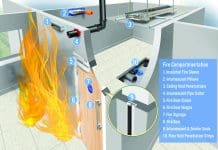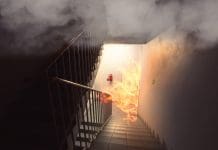A study conducted by the Building Research Establishment (BRE) in partnership with the Fire Industry Association (FIA) and key fire detection and alarm manufacturers has concluded that multi-sensor detectors are better at rejecting false alarms
The research was a continuation of prior research from three previous projects, which looked at the occurrence of false alarms in the UK. Over the past 10 years, the FIA and BRE have partnered with King’s College, Buckinghamshire Milton Keynes Fire Brigade, and Scotland Fire Brigade to investigate and find solutions to the false alarm problem that perpetuates across the UK.
Those previous projects provided anecdotal indication that employing multi-sensor fire detectors would help reduce the occurrence of false alarms. However, hard evidence was missing to establish how effective multi-sensors could be in reducing false alarms.
Categories of multi-sensor detectors
12 manufacturers from the UK and Europe were involved in the research. These represented most of the detectors sold in the UK. From those 12 manufacturers we put together 35 different detectors and those were tested against two standard optical smoke detectors, one commercial, and one domestic.
There are many different sorts of multi-sensors. The research focused on multi-sensor detectors which comprised of an optical smoke chamber together with a heat sensor. However, even within this detector type, performance varies greatly dependent upon the design and the settings used. As a result, the research graded them into three categories: ‘standard, intermediate and advanced performance’.
‘Standard’ multi-sensor detectors were those smoke/heat detectors which used the heat element to modify the response of the smoke sensor, meaning that the detector would respond more rapidly when heat is present. With no heat present the detector may then also delay its response.
The ‘intermediate’ category were the detectors that used a smoke chamber design that incorporated features of the ‘standard’ detectors, but with added design benefits, for example a more specifically designed chamber to eliminate potential for false alarms, such as an insect going into the chamber, or the effect of dust which may cause a false alarm.
The ‘advanced’ category, which the research predicted was the most likely to be the most effective at reducing false alarms, were those which had the features of the ‘standard’ and ‘intermediate’ categories, but also employed sophisticated targeted algorithms which would eliminate a false alarm.
 Comparing sensitivity
Comparing sensitivity
Following categorisation, the next stage of the research was to test the sensitivity of the different multi-sensor detectors compared to standard optical smoke detectors.
10 different fire tests were conducted, looking specifically at the performance of the detector and their ability to detect fires. The fire tests included the standard fire tests – TF2,3,4, and 5 – which are in EN54-7 the European standard for smoke detectors. TF1 and TF8 were then added, which are additional fire tests that have been included in EN 54-29, a new European standard for fire detectors combining smoke and heat sensors. TF1 is specifically a hot wood-burning fire that produces heat yet not much smoke, and TF8 is a fuel-burning fire that produces very little heat, but very heavy smoke. In this way, the testing represented the extreme ends of the spectrum for fires that may occur in real life.
A good fire detector needs to be used in almost every circumstance and must be able to detect a whole range of fire types that may be encountered depending on the fire risk.
To the 6 test fires listed above, 4 new fires were specifically designed for the research (these were not listed in EN54), to extend the range of test fire types. These were based on fire retardant material or MDF material, creating slow-burning fires, again replicating real-life situations.
All the detectors – both multi-sensors and optical smoke detectors were tested against all of the different test fires. You might expect that in terms of sensitivity and ability to detect fires that the multi-sensor detectors would perform better.
However, the research results were not so clear and it was difficult to differentiate very easily between the performance of the multi-sensors as a group and the performance of the standard optical smoke detectors. Essentially, detector performance depended very much on their sensitivity – the high sensitivity detectors detecting quicker and faster than the low sensitivity detectors. This held true for both multi-sensor detectors and standard optical smoke detectors. There was no real way of differentiating performance between the ‘old-style’ optical smoke detectors and the ‘new-type’ multi-sensor detectors.
Testing for false alarm rejection
In knowing that there was not much difference in ability to detect fires, the second test was then to test all the detectors in their ability to reject typical false alarm situations. Would the multi-sensor detectors perform better?
The false alarm testing was developed in conjunction with the University of Duisburg in Germany; the team there had some expertise in developing false alarm testing. In addition, bringing in a university meant that there was a further element of impartiality and independence from the industry as well.
Five different false alarm tests were carried out in total: burning toast, cooking, steam, dust, and aerosol spray. Other tests such as cigarette smoke and long-term dust were also considered, but these were abandoned because repeatable results were not possible due to the amounts of variability in these two tests.
What were the results?
There were two outcomes from the tests – the first being the results of the tests themselves, and the second outcome was that the initial grading of the multi-sensor detectors into ‘standard’, ‘intermediate’, and ‘advanced’ categories was correct.
During the false alarm tests all the multi-sensor detectors responded later than the optical smoke detectors – either the domestic or the commercial smoke alarms. For example, on the toast burning test, some of the multi-sensor detectors (those in the ‘advanced’ category) responded a good minute after the optical smoke detectors. By responding later, this demonstrates that multi-sensor detectors are not as prone to alarm as optical smoke detectors for events such as burning toast or steam, providing better overall resistance to false alarms.
Additionally, the fire tests justified the way the research categorized the different types of detectors – in that they all responded in the right order, i.e. the ‘standard’ category responded first (meaning they were not as good at rejecting false alarms), then the ‘intermediate’ category alarmed afterwards, and finally the ‘advanced’ category of detectors (which had the benefit of sophisticated algorithms to filter out false alarms), responded latest.
The conclusion? The more sophisticated the multi-sensor detector, the less likely they are to false alarm. And additionally, multi-sensor detectors are better at rejecting false alarms than optical smoke detectors of any category.
 The future
The future
With the conclusion that multi-sensor detectors are more effective at false alarm rejection, and that effectiveness increasing depending on the categorisation of the specific detector, there is scope in the future for the FIA to be involved with developing a means of grading detectors within the British and European Standards.
The FIA, in conjunction with other industry bodies and stakeholders, are also considering the introduction of new false alarm tests, that were developed for the research, within the European or British Standards. This means that detectors will come with a label identifying the level of resilience to specific types of false alarm.
Both of the above will help categorise detectors according to their ability to reject false alarms, ultimately meaning that users will be able to understand what they are buying, and for installation and maintenance companies to be able to recommend a category of detector to their clients to solve a false alarm issue within a building. This will be especially helpful where there are buildings that are particularly prone to false alarms – helping to minimise disruption to businesses and reduce strain on Fire and Rescue Service callouts.
Ultimately, this will have an impact on manufacturers and how they are going to create their products for the future. Designs may be re-evaluated for their level of effectiveness against false alarms – but of course, further research and development of products is more expensive. However, the benefits of developing these products may mean that we start to see even more sophisticated multi-sensor detectors on the market in the future.
To find out more about the FIA’s sponsorship and involvement with research, visit www.fia.uk.com.
Bernard Laluvein
Director of ADT Fire & Security
Chairman of the FIA’s Fire Detection and Alarm Council
Robert Yates
FIA Technical Manager
Secretary to the FIA’s Fire Detection and Alarm Council
www.fia.uk.com
Twitter: @FireIndustry






![[Video] Enhancing safety with fire doors: A case study of Marina Care Home](https://www.pbctoday.co.uk/news/wp-content/uploads/2025/06/maxresdefault-218x150.jpg)



![[VIDEO] Making DorTrak reports easy to read with Fireco Inspecting fire doors at Fireco, firedoor technology, 2023](https://www.pbctoday.co.uk/news/wp-content/uploads/2024/04/JPZ_2364-web-218x150.jpg)



